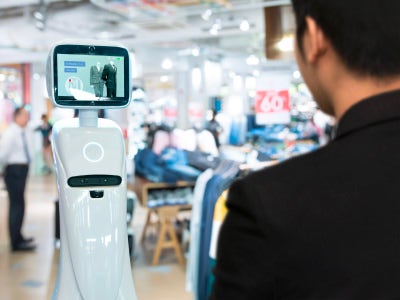
To be future-ready, get AI-ready
Business interest in artificial intelligence (AI) has never been higher. But even before generative AI was introduced, organizations were struggling to get the full value out of their AI implementations, according to our analysis of a recent Economist Impact study. Here are five changes businesses should make to succeed with AI.
data-xy-axis-lg:60% 20%; data-xy-axis-md:30% 0%; data-xy-axis-sm:60% 0px;
<h3>Introduction</h3> <p>Ever since generative artificial intelligence entered the business conversation late last year, it’s become impossible to separate the idea of being “future-ready” from adopting AI. With this powerful technology, businesses can attain the speed, agility and accurate decision-making they need to compete in today’s fast-changing environment.</p> <p>Even before generative AI came along, AI adoption was growing. In a recent study by Economist Impact, AI and machine learning (ML) were among the top six technologies respondents had already adopted or planned to adopt in their quest to be future-ready (see Figure 1). Cognizant partnered with Economist Impact on the study—which surveyed 2,000 global executives across industries—as part of our ongoing work to define what it takes to be future-ready and how close businesses are to reaching a future-ready state. (For the full study, see “<span class="text-regular"><a href="https://www.cognizant.com/en\_us/insights/documents/ready-for-anything-what-it-means-to-be-a-modern-business-wf1189596.pdf" target="_blank" title="Ready for anything: what it means to be a modern business" style="font-weight: normal;" rel="noopener noreferrer">Ready for anything: what it means to be a modern business</a>.</span>”)<br> <br> In our analysis of the data, nearly seven in 10 named AI/ML as a top investment area, indicating their belief that it‘s essential for doing business effectively today.</p>
AI is a top-6 most-used technology
<h3><span class="text-white"><b>Q: Which of the following technologies has your business adopted, or plans to adopt?</b></span></h3>
<p><span style="font-weight: normal;"><span class="text-primary">At the same time, however, just 39% of respondents said their AI/ML had already contributed significant business value. In fact, even though it was the sixth most-adopted technology, it was second to the bottom on the list in terms of its perceived value (see Figure 2).</span></span></p>
<p>The fact is—whether it’s generative AI or another type of AI—succeeding with AI/ML initiatives requires businesses to make a variety of unforeseen adjustments. The good news is, many businesses are beginning to attain the full value of their AI implementations. It starts with moving past the AI hype and understanding what it takes to succeed with this technology.</p>
Difficulty achieving full tech value
<h4><span style="font-weight: 300;">Q : To what extent are the technologies you've adopted delivering strategic value to your operations? (Percent of respondents saying significant value)</span></h4>
Mastering the five elements to be AI-ready
<p>Drawing on our analysis and experience, we have crafted five recommendations that enable traditional enterprises to proactively embrace AI. These recommendations center on orchestrating AI within a broader ecosystem encompassing data, technology, talent, responsible AI practices and organizational culture. By integrating these elements, enterprises can pave the way for a future in which AI becomes a driving force of their success.</p>
<h5>Jump to a section:</h5>
<div class="header-title"><div class="title-valign"><h3>1 </h3> <h4><span class="text-bold">Modernize data infrastructure</span></h4> </div> </div>
<div style="padding-right: 30.0px;"><p>Many businesses face the daunting challenges of inaccurate, incomplete and inconsistent data. Low-quality data threatens to sabotage the performance of AI models, resulting in wasted resources and missed opportunities.</p> <p>Investing in AI without addressing data quality challenges is akin to constructing a house on an unstable foundation. AI systems heavily rely on high-quality data to generate accurate insights and help you make informed decisions. Neglecting data quality compromises the very essence of AI's potential. It undermines the trust in AI systems, erodes confidence among stakeholders and jeopardizes desired outcomes.</p> <p><a style="font-weight: normal;" title="Data modernization" href="https://www.cognizant.com/us/en/insights/insights-blog/dont-make-a-move-until-youve-modernized-your-data-wf1892701" rel="noopener noreferrer">Data modernization</a> is the key to effectively managing and leveraging data assets, paving the way for AI-driven insights and transformative decision-making.</p> </div>
<h4 style="padding-right: 35.0px;"><span style="font-weight: normal;"><span class="text-light">Here are the essential elements involved in modernizing the data infrastructure that fuels the AI endeavors of forward-thinking companies:</span></span></h4>
These industry use cases exemplify the potential of a modernized data infrastructure in unleashing new opportunities with AI, fostering innovation and yielding substantial advantages:
<div class="header-title"><div class="title-valign"><h3>2 </h3> <h4><span class="text-bold">Overhaul legacy technology</span></h4> </div> </div>
<div style="padding-right: 30px;"><p>As AI adoption grows, organizations must confront a critical challenge: their outdated and rigid IT infrastructure. Legacy systems, with their integration complexities and lack of standardized APIs, struggle to keep pace with the computational demands and real-time data processing requirements of AI.</p> <p>Legacy infrastructure also pose a significant security risk. Built on foundations that predate the digital era, these systems were not designed to withstand the sophisticated attacks of today's threat landscape. </p> <p>By embracing the future and committing to modernizing their infrastructure, organizations unlock heightened efficiency, accelerated innovation and the ability to redefine what's possible.</p> </div>
<h4 style="padding-right: 35.0px;"><span style="font-weight: normal;"><span class="text-light">These recommendations will help businesses build an agile and resilient IT infrastructure that safely and securely supports the computational intensity and vast data volumes needed for AI:</span></span></h4>
These industry use cases demonstrate the power of modernization efforts in unlocking improved outcomes, driving innovation and gaining a competitive edge in the AI-powered digital landscape:
<div class="header-title"><div class="title-valign"><h3>3 </h3> <h4><span class="text-bold">Invest in AI talent</span></h4> </div> </div>
<div style="padding-right: 30px;"><p>Many businesses are struggling to find AI talent, including machine learning, natural language processing and computer vision, as well as soft skills like creativity and problem-solving. Those that do find it are often forced to pay top dollar. </p> <p>The rapid evolution of AI necessitates professionals who not only possess existing skills but also have the capacity for continuous learning and adaptation. </p> <p>Retaining these professionals proves to be equally arduous. Talented AI professionals are constantly courted by new and exciting opportunities.</p> </div>
<h4 style="padding-right: 35.0px;"><span style="font-weight: normal;"><span class="text-light">Overcoming these challenges requires a multi-faceted approach to acquire and nurture AI talent, ensuring a strong workforce capable of driving innovation and achieving AI excellence:</span></span></h4>
Here’s how three companies are working to overcome AI talent challenges:
<div class="header-title"><div class="title-valign"><h3>4 </h3> <h4><span class="text-bold">Prioritize responsible AI</span></h4> </div> </div>
<div style="padding-right: 30px;"><p>From biased algorithms to privacy concerns, companies find themselves facing a new frontier of ethical dilemmas, from how to ensure AI systems are fair and unbiased, to preventing them from being used for harmful purposes, to ensuring they are transparent and accountable.</p> <p>Failure to address biased algorithms, privacy infringements and ethical decision-making by autonomous systems can unleash a torrent of consequences. Embracing the ethical dimensions of AI is not an option—it is an imperative.</p> </div>
<h4 style="padding-right: 35.0px;"><span style="font-weight: normal;"><span class="text-light">Businesses should view these ethical challenges as catalysts for growth rather than obstacles. By taking a firm stance on responsible AI, companies can lead the way toward a safe and secure future. Here are the essential steps that organizations can take to forge a powerful alliance with AI:</span></span></h4>
The following companies are integrating responsible AI practices into their operations and demonstrating a commitment to achieving positive outcomes for their customers, employees and the broader society:
<div class="header-title"><div class="title-valign"><h3>5 </h3> <h4><span class="text-bold">Foster an AI-friendly culture</span></h4> </div> </div>
<div style="padding-right: 30.0px;"><p>The path to AI-readiness stretches far beyond technological prowess. It demands a cultural metamorphosis that embraces change and dispels misperceptions and fear. </p> <p>For example, fear of job displacement and uncertainty can spur doubt regarding the potential of AI, while a limited understanding of AI can also stifle its adoption because of skepticism or a lack of trust in its insights. </p> <p>Businesses also need a strong cultural foundation to address the complex ethical dilemmas associated with AI, including establishing guidelines and frameworks for responsible AI use, and promoting open discussions and diverse perspectives.</p> </div>
<h4 style="padding-right: 35.0px;"><span style="font-weight: normal;"><span class="text-light">With the following steps, businesses can cultivate an organizational culture prepared for AI success:</span></span></h4>
These companies are effectively tackling cultural challenges in the adoption of AI:
What to do on Monday?
<p><span class="text-primary">As the transformative power of AI becomes increasingly evident, forward-thinking companies are recognizing that AI is not just a buzzword but a strategic tool that holds the key to unlocking innovation, efficiency and growth. The question is how to harness AI to get the full value out of this powerful technology.</span></p> <h5><span class="text-primary" style="font-weight: normal;">Here are our recommendations to ensure your readiness for the future:</span></h5>
#jump-to-section-wrapper .teaser-wrapper{ display: unset; } #jump-to-section-wrapper .teaser-wrapper img{ min-height: 125px; } #text_light_one span,#text_light_one h4,#text_light_two h4,#text_light_three h4,#text_light_four h4,#text_light_five h4{ font-weight: 300 !important; } #ai-is-a-top-6-most-used-technology, #difficulty-achieving-full-tech-value{ font-size: 27px; } #Foster_an_AI-friendly_culture_box1{ background-color: #97F5F7; } #Foster_an_AI-friendly_culture_box1 h2, #Foster_an_AI-friendly_culture_box1 h6{ color : #000048; } #Foster_an_AI-friendly_culture_tile1 .cmp-teaser__description, #Foster_an_AI-friendly_culture_tile2 .cmp-teaser__description { border: 0; border-bottom: 4px solid; -o-border-image: linear-gradient(35deg,#2d2d8f 10%,#006fba 50%,#21fceb 94%) 1; border-image: linear-gradient(35deg,#2d2d8f 10%,#006fba 50%,#21fceb 94%) 1; margin-bottom: 1rem; } #Foster_an_AI-friendly_culture_tile4{ border: none; } #Foster_an_AI-friendly_culture_tile1 .cmp-teaser__description p:nth-child(2), #Foster_an_AI-friendly_culture_tile2 .cmp-teaser__description p:nth-child(2) { padding-bottom: 20px; } #Foster_an_AI-friendly_culture_tile2 .cmp-teaser__content, #Foster_an_AI-friendly_culture_tile3 .cmp-teaser__content, #Foster_an_AI-friendly_culture_tile4 .cmp-teaser__content { margin-top: 40px; } #modernize-data-infrastructure-box1 p, #overhaul-legacy-technology-box1 p{ font-size: 14px; } #modernize-data-infrastructure, #overhaul-legacy-technology, #invest-in-ai-talent, #prioritize-responsible-ai, #foster-an-ai-friendly-culture { height: 100%; } #Prioritize_responsible_AI_tile1 .cmp-teaser__description, #Prioritize_responsible_AI_tile2 .cmp-teaser__description { border: 0; border-bottom: 4px solid; -o-border-image: linear-gradient(35deg,#2d2d8f 10%,#006fba 50%,#21fceb 94%) 1; border-image: linear-gradient(35deg,#2d2d8f 10%,#006fba 50%,#21fceb 94%) 1; margin-bottom: 1rem; } #Prioritize_responsible_AI_tile3{ border: none; } #Prioritize_responsible_AI_tile1 .cmp-teaser__description p:nth-child(2), #Prioritize_responsible_AI_tile2 .cmp-teaser__description p:nth-child(2) { padding-bottom: 20px; } #Prioritize_responsible_AI_tile2 .cmp-teaser__content, #Prioritize_responsible_AI_tile3 .cmp-teaser__content { margin-top: 40px; } @media (min-width:1025px) { /* big landscape tablets, laptops, and desktops */ div#Innovation_teaser p { width: 60%; margin-bottom: 0; } div#exetxt_container { padding-right: 80px; } /* big landscape tablets, laptops, and desktops */ } /* hi-res laptops and desktops */ @media (min-width:1281px) { div#exetxt_container { padding-right: 80px; } } /* hi-res laptops and desktops */ #fourteaser { padding: 0 1rem !important; } #inves-in-ai-talent-box4 h1, #inves-in-ai-talent-box4 h6{ color : #fff; } #inves-in-ai-talent-box4 h6, #fourteaser .teaser-content h6 { font-weight: normal; } #Modernize_data_infrastructure_box1 p{ font-size: 14px; } #Invest_in_AI_talent_tile3{ border: none; } #invest-in-ai-talent-tile1 .teaser-content p:nth-child(2), #invest-in-ai-talent-tile2 .teaser-content p:nth-child(2) { padding-bottom: 20px; } #invest-in-ai-talent-tile2 .teaser-content, #invest-in-ai-talent-tile3 .teaser-content { margin-top: 20px; } #Overhaul_legacy_technology_box1 p{ font-size: 14px; } #Overhaul_legacy_technology_tile1 .cmp-teaser__description, #Overhaul_legacy_technology_tile2 .cmp-teaser__description, #Overhaul_legacy_technology_tile3 .cmp-teaser__description { border: 0; border-bottom: 4px solid; -o-border-image: linear-gradient(35deg,#2d2d8f 10%,#006fba 50%,#21fceb 94%) 1; border-image: linear-gradient(35deg,#2d2d8f 10%,#006fba 50%,#21fceb 94%) 1; margin-bottom: 1rem; } #Overhaul_legacy_technology_tile4{ border: none; } #overhaul-legacy-technology-tile1 .teaser-content p:nth-child(2), #overhaul-legacy-technology-tile2 .teaser-content p:nth-child(2), #overhaul-legacy-technology-tile3 .teaser-content p:nth-child(2) { padding-bottom: 20px; } #overhaul-legacy-technology-tile2 .teaser-content, #overhaul-legacy-technology-tile3 .teaser-content, #overhaul-legacy-technology-tile4 .teaser-content { margin-top: 20px; } #Modernize_data_infrastructure_box1 p{ font-size: 14px; } #Modernize_data_infra_border_btm_tile4{ border: none; } #modernize-data-infra-border-btm-tile1 .teaser-content p:nth-child(2), #modernize-data-infra-border-btm-tile2 .teaser-content p:nth-child(2), #modernize-data-infra-border-btm-tile3 .teaser-content p:nth-child(2) { padding-bottom: 20px; } #modernize-data-infra-border-btm-tile2 .teaser-content, #modernize-data-infra-border-btm-tile3 .teaser-content, #modernize-data-infra-border-btm-tile4 .teaser-content, #prioritize-responsible-ai-tile3 .teaser-content { margin-top: 20px; } #foster-an-ai-friendly-culture-tile1 .teaser-content p:nth-child(2), #foster-an-ai-friendly-culture-tile2 .teaser-content p:nth-child(2), #foster-an-ai-friendly-culture-tile3 .teaser-content p:nth-child(2) { padding-bottom: 20px; } #foster-an-ai-friendly-culture-tile1 .teaser-content, #foster-an-ai-friendly-culture-tile2 .teaser-content, #foster-an-ai-friendly-culture-tile3 .teaser-content { margin-top: 20px; } #exe_teaser2_one .cmp-teaser__description, #exe_teaser2_two .cmp-teaser__description, #exe_teaser2_three .cmp-teaser__description, #exe_teaser2_four .cmp-teaser__description, #exe_teaser2_five .cmp-teaser__description{ position: relative; } #jump-to-section-wrapper .teaser-content { align-content: center !important; position: relative; min-height: 125px; } #jump-to-section-wrapper .teaser .teaser-image a { pointer-events: none !important; } #modernize-data-infrastructure a, #overhaul-legacy-technology a, #invest-in-ai-talent a, #prioritize-responsible-ai a, #foster-an-ai-friendly-culture a{ font-size: 27px; color: #2f78c4; font-weight: normal; margin: 0; -ms-transform: translateY(-50%); transform: translateY(-50%); width: -webkit-fill-available; word-break: initial; } #modernize-data-infrastructure, #overhaul-legacy-technology, #invest-in-ai-talent, #prioritize-responsible-ai, #foster-an-ai-friendly-culture{ line-height: normal !important; } #modernize-data-infrastructure a:hover, #overhaul-legacy-technology a:hover, #invest-in-ai-talent a:hover, #prioritize-responsible-ai a:hover, #foster-an-ai-friendly-culture a:hover{ color: #000048; } #exe_teaser2-image img, div#exe_right .cmp-teaser__content{ min-height : 125px !important; } div#exe_right { margin-top: 10px; } div#exe_right .cmp-teaser__title{ font-size: 22px; margin-bottom: 10px; font-weight: bold; } div#exe-right .cmp-container .cog-teaser.horizontal-view { padding: 0 0 !important; } #jump-to-section-wrapper .teaser-content{ padding: 10px 10px 10px 30px!important; } #exe-teaser2-one,#exe-teaser2-two,#exe-teaser2-three,#exe-teaser2-four,#exe-teaser2-five, #exe-teaser4,#exe-teaser6,#exe-teaser8 { background-color: white !important; border: 1px solid #D0D0CE; font-weight: 400; min-height: 125px; } div#exe-right .teaser .cmp-teaser { background-color: #000048 ; } div#exe-right .cmp-container { padding-bottom: 12px; } div#exe-teaser2-one .cmp-teaser__title, div#exe_teaser2_two .cmp-teaser__title, div#exe_teaser2_three .cmp-teaser__title, div#exe_teaser2_four .cmp-teaser__title, div#exe_teaser2_five .cmp-teaser__title, div#exe_teaser4 .cmp-teaser__title,div#exe_teaser6 .cmp-teaser__title,div#exe_teaser8 .cmp-teaser__title { font-weight: bold; color: #000048; } div#exe_right .teaser .cmp-teaser .cmp-teaser__action-link { padding: 8px 12px; font-size: 14px; margin-top: 0; } div#exe_teaser2_one .cmp-teaser__title,div#exe_teaser2_two .cmp-teaser__title,div#exe_teaser2_three .cmp-teaser__title, div#exe_teaser2_four .cmp-teaser__title, div#exe_teaser2_five .cmp-teaser__title, div#exe_teaser4 .cmp-teaser__action-link,div#exe_teaser6 .cmp-teaser__action-link,div#exe_teaser8 .cmp-teaser__action-link { border-color: #2f78c4; color: #2f78c4; } div#exe_teaser2_one .cmp-teaser__action-link:hover,div#exe_teaser2_two .cmp-teaser__action-link:hover,div#exe_teaser2_three .cmp-teaser__action-link:hover,div#exe_teaser2_four .cmp-teaser__action-link:hover,div#exe_teaser2_five .cmp-teaser__action-link:hover, div#exe_teaser4 .cmp-teaser__action-link:hover, div#exe_teaser6 .cmp-teaser__action-link:hover, div#exe_teaser8 .cmp-teaser__action-link:hover { color: #6AA2DC; border-color: #6AA2DC; } #AI_top6_most_used_techno_div_para{ font-size: 14px; line-height: 20px; color: #fff; } #answer-teaser-div .cmp-teaser .teaser-content { margin: 0; } #answer-teaser-div .teaser-wrapper{ color: #fff !important; padding: 0 15px; } #answer-teaser-div .teaser-wrapper:last-of-type{ font-size: 14px !important; } #answer-teaser-div .teaser-wrapper h5{ margin-bottom: 0; } #AI_top6_most_used_techno_div_para .cmp-teaser__content{ padding-top: 0rem; } #Foster_an_AI-friendly_culture_box1 .cmp-teaser__description p { font-size: 16px; color: #000048; } #seventyseven p a{ font-size: 16px; color: #2f78c4 !important; } #Foster_an_AI-friendly_culture_box1 .cmp-teaser__description p a:hover{ color: #000048 !important; } .header-title h3{ font-size: 6rem; margin-bottom: 0; color: #92BBE6; } .header-title h4{ font-size: 3rem; margin-bottom: 0; } .title-valign{ display: inline-flex; vertical-align: middle; align-content: center; align-items: center; } #spy-modernize-data-infrastructure, #spy-overhaul-legacy-technology, #spy-invest-in-ai-talent, #spy-prioritize-responsible-ai, #spy-foster-an-ai-friendly-culture{ height : 350px; position: relative; } #spy-modernize-data-infrastructure .text, #spy-overhaul-legacy-technology .text, #spy-invest-in-ai-talent .text, #spy-prioritize-responsible-ai .text, #spy-foster-an-ai-friendly-culture .text { margin: 0; position: absolute; top: 50%; -ms-transform: translateY(-50%); transform: translateY(-50%); padding-right: 0.5rem; } #company_tiles_one .cog-teaser.vertical-view .cmp-teaser__image img, #company_tiles_two .cog-teaser.vertical-view .cmp-teaser__image img, #company_tiles_three .cog-teaser.vertical-view .cmp-teaser__image img{ width: 85% !important; padding-top: 15px; padding-bottom: 15px; } #Amex_image_section5-image img{ object-fit: fill !important; } #Layer_2,#Layer_1{ width: 100%; } #what-to-do-container .text { padding-top: 1rem; } @media (min-width: 600px) { #answer-teaser-div { padding-top: 5rem !important; } } /* Extra small devices (phones, 600px and down) */ @media only screen and (max-width: 600px) { .header-title h3 { font-size: 3rem; margin-bottom: 0; color: #92BBE6; } .header-title h4 { font-size: 2rem; margin-bottom: 0; } .title-valign { display: unset !important; } #company_tiles_one .cog-teaser.vertical-view .cmp-teaser__image img, #company_tiles_two .cog-teaser.vertical-view .cmp-teaser__image img, #company_tiles_three .cog-teaser.vertical-view .cmp-teaser__image img{ width: 50% !important; } #Layer_1 { height: 400px; margin-bottom: -120px; margin-top: -100px; width: 350px; } #Layer_2 { height: 400px; margin-bottom: -120px; margin-top: -100px; width: 350px; } } #calltoaction h5 { margin-bottom: 0; } .text-light { color: #000048 !important; } #industries-five-wrapper .teaser-image, #industries-three-wrapper .teaser-image, #industries-four-wrapper .teaser-image, #industries-four-wrapper .teaser-image{ text-align: center; } #industries-five-wrapper .teaser.cog-teaser.vertical-view.icon-image img, #industries-three-wrapper .teaser.cog-teaser.vertical-view.icon-image img, #industries-four-wrapper .teaser.cog-teaser.vertical-view.icon-image img{ width: 85% !important; padding-top: 15px; padding-bottom: 15px; object-fit: fill; } #industries-five-wrapper .teaser.cog-teaser.vertical-view .teaser-content > div:first-of-type, #industries-three-wrapper .teaser.cog-teaser.vertical-view .teaser-content > div:first-of-type, #industries-four-wrapper .teaser.cog-teaser.vertical-view .teaser-content > div:first-of-type { display: block; } #sixtyteaser, #hundredandfourteenteaser{ padding-top: 0!important; } #sixtyteaser h6, #hundredandfourteenteaser h6 { font-weight: normal; } #overhaul-legacy-technology--, #invest-in-ai-talent--, #prioritize-responsible-ai--{ font-size: 1.5rem; } #modernize-data-infra-border-btm-tile1 .cmp-teaser, #modernize-data-infra-border-btm-tile2 .cmp-teaser, #modernize-data-infra-border-btm-tile3 .cmp-teaser, #overhaul-legacy-technology-tile1 .cmp-teaser, #overhaul-legacy-technology-tile3 .cmp-teaser { border: 0; border-bottom: 4px solid; -o-border-image: linear-gradient(35deg, #2d2d8f 10%, #006fba 50%, #21fceb 94%) 1; border-image: linear-gradient(35deg, #2d2d8f 10%, #006fba 50%, #21fceb 94%) 1; margin-bottom: 1rem; } #overhaul-legacy-technology-tile2 .cmp-teaser, #invest-in-ai-talent-tile1 .cmp-teaser, #invest-in-ai-talent-tile2 .cmp-teaser, #foster-an-ai-friendly-culture-tile1 .cmp-teaser, #foster-an-ai-friendly-culture-tile2 .cmp-teaser{ border: 0; border-bottom: 4px solid; -o-border-image: linear-gradient(35deg, #2d2d8f 10%, #006fba 50%, #21fceb 94%) 1; border-image: linear-gradient(35deg, #2d2d8f 10%, #006fba 50%, #21fceb 94%) 1; margin-bottom: 1rem; } #twoteaser .teaser-wrapper{ display: block; } #fourteaser .teaser-wrapper .teaser.cog-teaser.vertical-view { width: 100%; } #twoteaser .teaser-content h6, #foster-an-ai-friendly-culture-box1 h6 { font-weight: normal; } #seventyseven { padding-top: 0 !important; } #foster-an-ai-friendly-culture-box1 { background: #97F5F7; } #foster-an-ai-friendly-culture-box1 h2, #foster-an-ai-friendly-culture-box1 h6 { color: #000048; } #foster-an-ai-friendly-culture-box1 .teaser-content p { font-size: 16px; color: #000048; } .hero.block .row { padding-top: 2rem !important; padding-bottom: 2rem !important; } #seventyseven a:hover { color: var(--primary) !important; } #seventyseven p a { color: var(--accent2-dark) !important; } #jump-to-section-wrapper h5{ font-size: 20px; font-weight: bold; } #industries-three-wrapper .teaser-content a, #industries-four-wrapper .teaser-content a, #industries-five-wrapper .teaser-content a{ text-decoration: underline; } #twoteaser { padding-top: 0px !important; } #aimodels, #leadtop { padding: 0; } .teaser.cog-teaser.vertical-view .teaser-content { margin: 20px; } #spy-invest-in-ai-talent .default-content-wrapper picture img, #spy-prioritize-responsible-ai .default-content-wrapper picture img, #spy-foster-an-ai-friendly-culture .default-content-wrapper picture img{ object-position: 70% top; } /* Medium devices (landscape tablets, 860px and down) */ @media only screen and (max-width: 860px ) { #Layer_2,#Layer_1{ width: 100%; } div#exe_right .teaser .cmp-teaser .cmp-teaser__content .cmp-teaser__description h4 a { font-size: 20px; } #jump-to-section-wrapper h4 a { font-size: 20px; } .header-title h3 { font-size: 4rem; margin-bottom: 0; color: #92BBE6; } .header-title h4 { font-size: 2.5rem; margin-bottom: 0; } #industries-five-wrapper .teaser.cog-teaser.vertical-view.icon-image img, #industries-three-wrapper .teaser.cog-teaser.vertical-view.icon-image img, #industries-four-wrapper .teaser.cog-teaser.vertical-view.icon-image img { width: 60% !important; } } /* Extra small devices (phones, 600px and down) */ @media only screen and (max-width: 600px) { .header-title h3 { font-size: 3rem; margin-bottom: 0; color: #92BBE6; } .header-title h4 { font-size: 2rem; margin-bottom: 0; } #industries-five-wrapper .teaser.cog-teaser.vertical-view.icon-image img, #industries-three-wrapper .teaser.cog-teaser.vertical-view.icon-image img, #industries-four-wrapper .teaser.cog-teaser.vertical-view.icon-image img { width: 50% !important; } } #fourteaser .teaser-wrapper .teaser.cog-teaser.vertical-view.bg-accent1-dark { background-color: var(--accent1-dark) !important; } #fourteaser .teaser-wrapper .teaser.cog-teaser.vertical-view.bg-accent1-medium { background-color: var(--accent1-medium) !important; } #twoteaser .teaser-wrapper .teaser.cog-teaser.vertical-view.bg-accent2-light { background-color: var(--accent2-light) !important; } #foster-an-ai-friendly-culture-box1 .cmp-teaser { background: #97F5F7 !important; }



















